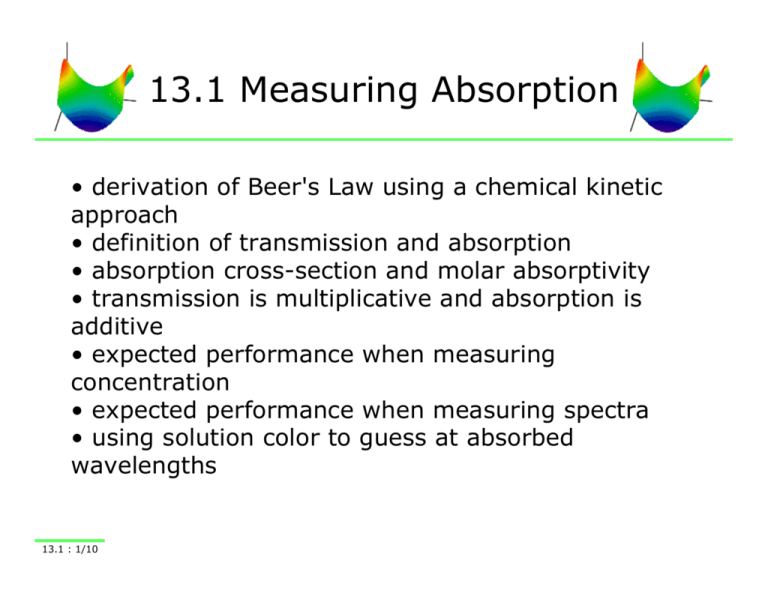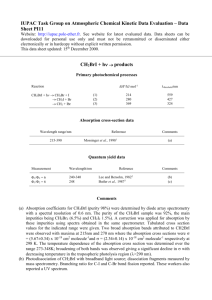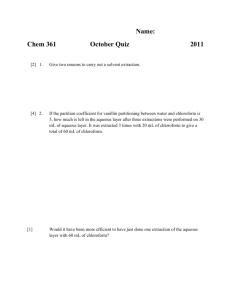13.1 Measuring Absorption
advertisement

13.1 Measuring Absorption • derivation of Beer's Law using a chemical kinetic approach • definition of transmission and absorption • absorption cross-section and molar absorptivity • transmission is multiplicative and absorption is additive • expected performance when measuring concentration • expected performance when measuring spectra • using solution color to guess at absorbed wavelengths 13.1 : 1/10 Kinetic Derivation of Beer's Law (1) The process of absorption can be written as a "reaction" involving light and two energy states. ΔE = hν S2 B 1,2 S1 + hν ⎯⎯⎯ → S2 A second-order rate equation can be written for the reaction, B1,2 S1 where ρ(ν) is the density of light in cm-3, N1 is the number density of S1 in cm-3, and B1,2 is the second order rate constant (called the ___________________ for absorption). B1,2 has units of cm3 s-1. 13.1 : 2/10 Kinetic Derivation of Beer's Law (2) Of more interest is the change in photon density with distance through the sample. This is obtained using, dx/dt = c. σ has units of cm2 and is called the absorption cross-section. The total change in the photon density over a distance, l, is obtained by integration. By converting photon density into intensity, I = ρ(ν)×c, the final equation can be written in terms of an intensity ratio, I/I0. 13.1 : 3/10 d ρ (ν ) B1,2 d ρ (ν ) dt ρ (ν ) N1 =− dt dx c = dx B1,2 σ≡ c l d ρ (ν ) ∫ ρ (ν ) 0 l = −σ N1 ∫ dx 0 ⎛ ρ (ν ) ⎞ l = −σ lN ln ⎜ ⎟ 1 ⎜ ρ (ν ) ⎟ 0⎠ ⎝ Transmission and Absorption Transmission is defined as the intensity of light leaving the sample, divided by the intensity of light entering the sample. Transmission can be related to number density using the last equation on the previous transparency. I = 10 T≡ I0 − σ lN 2.3 I0 I = 10−ε lC Although the previous derivation used number density and crosssection, the more common units of molar absorptivity, ε, and molar concentration, C, give the same numeric result. Absorption is defined as the negative logarithm (base 10) of the transmission. This gives a parameter linear in concentration. 13.1 : 4/10 Cross-Section and Absorptivity Cross-sections and number densities are used in virtually every type of spectroscopy ______ solution-phase, molecular absorption. When comparing different spectroscopies, it is necessary to use cross-sections. The conversion between ε and σ involves nothing more than units. ) σ ( cm ) = ε ( L mol-1 cm-1 ) 6.02 × 1023 ( mol-1 ) 2 ( 2.3 × 103 cm3 L−1 In the UV/visible the maximum molar absorptivity is ______, which corresponds to a cross-section of ________________. The cross-section has nothing to do with the size of the molecule. Indeed, atoms have absorption cross-sections of ~10-13 cm2. The maximum cross-section comes from antenna theory and is (λ/2)2, which for 500 nm radiation is 6.25×10-10 cm2. 13.1 : 5/10 Measuring Absorption Optical Parameters with I0 = 5 μW A T I(μW) 0.001 0.01 0.1 0.9977 0.9772 0.7943 1 2 3 0.1 0.01 0.001 4.9885 4.8862 3.9716 0.5000 0.0500 0.0050 _____ absorption problem: I and I0 are nearly the same value. In order to measure an absorption of 0.001 the instrument has to measure I to a precision of at least 0.23%. _____ absorption problem: I is difficult to distinguish from 0. In order to measure an absorption of 3, the instrument has to have three orders of magnitude of linearity, i.e. I = 10-3 I0. The detector and electronics must have a high precision and large ___________________. Top-of-the-line: 10-4 to 5; intermediate: 10-3 to 3; inexpensive: 0.01 to 2. 13.1 : 6/10 Absorption Adds Consider a solution in a 1-cm cell that has a transmission of 0.5. It doesn't matter how much light enters the cell, only half will exit. Now place two such cells back-to-back. The combination will transmit 0.5×0.5 = 0.25 of the light, thus it is seen that transmission is multiplicative. Since absorption is the negative log of transmission, it can be seen that absorption adds. -log(Ttotal) = -log(T1 × T2) = -logT1 + -logT2 Atotal = A1 + A2 The most common use of additive absorption involves two or more molecules in the same solution. A(λ1) = ε1,1(λ1)C1 + ε2,1(λ1)C2 A(λ2) = ε1,2(λ2)C1 + ε2,2(λ2)C2 Solve by matrix algebra. 13.1 : 7/10 Measuring Concentration Performance can be estimated from Beer's Law. Assume that an absorbance of 0.01 will provide a satisfactory signal-to-noise ratio. An optimistic estimate: assume ε = 105 and l = 10 cm. C= A 0.01 = = 10−8 M ε l 105 × 10 A realistic estimate: assume ε = 104 and l = 1 cm. C= A 0.01 = = 10−5 M ε l 104 × 1 For a given determination, the _________________ can be extended by using cells of different length. Commercially available lengths are: 10, 5, 2, 1, 0.5, 0.2, 0.1 and 0.01 cm. 13.1 : 8/10 Measuring Spectra The SNR at the peak has to be sufficiently large to observe small features. SNR = ____ data cannot be compared to a reference spectrum. 0.04 SNR = 30 0.03 SNR = ____ data cannot be identified with great reliability. SNR = ____ is required to obtain a faithful representation of the true spectrum. absorption SNR = 3 0.02 0.01 0 400 450 500 -0.01 wavelength (nm) Minimum concentrations for a spectrum are ~100× the minimum concentration for quantitation. 13.1 : 9/10 550 Color and Absorption Maximum An artist's color wheel can be used to determine the absorption maximum. Absorption occurs at the _____________ of the solution color. Thus, a yellow-colored solution absorbs in the ________. violet yellow Use the table below to convert color to wavelength. Thus, a yellow-colored solution absorbs near 400 nm. A colorless solution absorbs in the __________. Color and Approximate Wavelength color violet blue green yellow orange red λ (nm) 400 450 500 550 600 650 13.1 : 10/10







